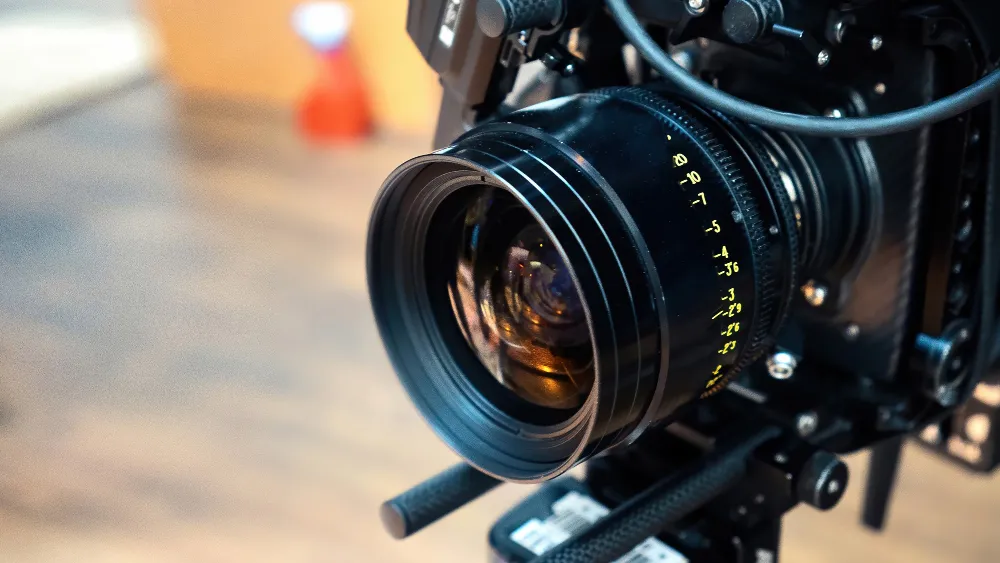Have you ever found yourself lost in the middle of a technical conversation, feeling that every word you don’t understand takes you further away from your creative vision?
Don’t worry, I’m here to help. In this article, I’m going to introduce you to 100 essential video production terms you should know. Whether you’re just starting out in this field or simply want to consolidate your knowledge, my goal is to provide you with a clear and precise guide that will clear your doubts and strengthen your video production skills.
| No. | First Letter | Term | Production Phase |
| 1 | A | Ambient sound | Post-production |
| 2 | A | Animation | Post-production |
| 3 | A | Aspect ratio | Production |
| 4 | A | Aspect ratio | Post-production |
| 5 | A | Audio levels | Post-production |
| 6 | B | B-roll | Production |
| 7 | B | Best boy | Production |
| 8 | B | Bit rate | Post-production |
| 9 | B | Blocking | Production |
| 10 | B | Boom mic | Production |
| 11 | B | Box office | Distribution |
| 12 | C | Call sheet | Pre-production |
| 13 | C | Casting director | Pre-production |
| 14 | C | CGI | Post-production |
| 15 | C | Chroma key | Post-production |
| 16 | C | Cinematographer | Production |
| 17 | C | Clapper loader | Production |
| 18 | C | Close-up | Production |
| 19 | C | Color grading | Post-production |
| 20 | C | Continuity | Production |
| 21 | C | Costume designer | Pre-production |
| 22 | C | Coverage | Production |
| 23 | C | Crane shot | Production |
| 24 | C | Cross dissolve | Post-production |
| 25 | C | Cutaway | Production |
| 26 | D | Director | Production |
| 27 | D | Distribution | Distribution |
| 28 | D | Dolly | Production |
| 29 | D | Drone | Production |
| 30 | E | Editor | Post-production |
| 31 | E | Establishing shot | Production |
| 32 | E | Exporting | Post-production |
| 33 | F | Fade in | Post-production |
| 34 | F | Fade out | Post-production |
| 35 | F | Film festival | Distribution |
| 36 | F | Final cut | Post-production |
| 37 | F | Focus puller | Production |
| 38 | F | Foley | Post-production |
| 39 | F | Frame rate | Production |
| 40 | G | Gaffer | Production |
| 41 | G | Gimbal | Production |
| 42 | G | Green screen | Post-production |
| 43 | H | High definition | Production |
| 44 | J | Jib | Production |
| 45 | J | Jump cut | Post-production |
| 46 | K | Key grip | Production |
| 47 | L | Lav mic | Production |
| 48 | L | Location permit | Pre-production |
| 49 | L | Location scout | Pre-production |
| 50 | L | Log format | Post-production |
| 51 | M | Makeup artist | Pre-production |
| 52 | M | Match cut | Post-production |
| 53 | M | Matte painting | Post-production |
| 54 | M | Medium shot | Production |
| 55 | M | Mic | Production |
| 56 | M | Montage | Post-production |
| 57 | M | Motion capture | Post-production |
| 58 | N | Non-linear editing | Post-production |
| 59 | P | Pan | Production |
| 60 | P | Pickup | Production |
| 61 | P | Post-production | Post-production |
| 62 | P | Pre-production | Pre-production |
| 63 | P | Producer | Production |
| 64 | P | Production | Production |
| 65 | P | Production designer | Pre-production |
| 66 | P | Production schedule | Pre-production |
| 67 | P | Proxy files | Post-production |
| 68 | R | RAW footage | Post-production |
| 69 | R | Reel | Post-production |
| 70 | R | Rehearsal | Production |
| 71 | R | Rendering | Post-production |
| 72 | R | Resolution | Production |
| 73 | R | Rough cut | Post-production |
| 74 | S | Scene | Production |
| 75 | S | Screenwriter | Pre-production |
| 76 | S | Script breakdown | Pre-production |
| 77 | S | Script supervisor | Production |
| 78 | S | Sequencing | Post-production |
| 79 | S | Shooting script | Pre-production |
| 80 | S | Shoot | Production |
| 81 | S | Slating | Production |
| 82 | S | Sound editing | Post-production |
| 83 | S | Sound mixing | Post-production |
| 84 | S | Soundtrack | Post-production |
| 85 | S | Special effects (SFX) | Post-production |
| 86 | S | Storyboard | Pre-production |
| 87 | S | Sync sound | Production |
| 88 | T | Take | Production |
| 89 | T | Tilt | Production |
| 90 | T | Timecode | Production |
| 91 | V | Visual effects (VFX) | Post-production |
| 92 | V | Voice-over | Post-production |
| 93 | W | White balance | Production |
| 94 | W | Wide shot | Production |
| 95 | W | Wrap | Production |
| 96 | Z | Zoom | Production |
| 97 | 4 | 4K | Production |
| 98 | 8 | 8K | Production |
| 99 | S | Screening | Distribution |
| 100 | D | Distribution | Distribution |
General Terms
- Storyboard: A graphic representation of how a production will visually unfold, frame by frame. Example: Creating a storyboard for a TV commercial to visualize transitions between scenes.
- Technical Script: A detailed document that includes technical information for each scene, such as camera angles, movements, and lighting. Example: The director of photography prepares a technical script to coordinate shots for an action sequence.
- Copyright: Laws that protect creators’ intellectual property over their works. Example: Securing the copyright for an original soundtrack before incorporating it into a film.
- Production Proposal: Document that presents the concept of a video project and details such as budget and schedule. Example: A producer submits a production proposal to potential investors for a documentary.
- Reel: Compilation of video clips that showcases the work and skills of a professional. Example: A video editor creates a reel to showcase their best work in color editing.
- Bitrate: The amount of data transmitted in a video per second. Example: Choosing a higher bitrate to ensure better video quality in a live stream.
- B-roll: Secondary footage used to cut away from the main shots and add visual interest. Example: Using B-roll clips of the city to complement an interview with a mayor.
- Casting: The process of selecting actors for various roles in a production. Example: Holding auditions to find the lead for a short film.
- Clip: A short segment of video. Example: Extracting a clip from a concert to use in a social media promotion.
- Compression: Reduction of a video file size to facilitate its storage or transmission. Example: Compressing a finished video for uploading to an online platform.
Pre-production Terms
- Treatment: Document that describes the vision and style of the project before the full screenplay is written. Example: Writing a treatment to pitch the idea of a series to a producer.
- Script: Text containing the dialogue and instructions for the making of a movie or program. Example: Developing a detailed script for an independent film.
- Script Breakdown: List of all necessary elements for each scene, such as actors, costumes, and locations. Example: The assistant director performs a script breakdown to organize the shooting schedule.
- Shooting Plan: Schedule detailing when and where each part of the script will be filmed. Example: Crafting a tight shooting plan to film all exterior scenes in three days.
- Location Scouting: Process of searching and selecting places to film the scenes of a production. Example: Visiting several beaches to choose the best location for a romantic movie scene.
- Production Budget: Detailed estimate of all costs associated with making a video project. Example: Creating a production budget that includes personnel, equipment, and location costs.
- Production Design: Creation of the visual and aesthetic appearance of a production. Example: The production designer decides the colors and styles of the sets for a period film.
- Crew Hiring: Process of selecting and hiring the technical and creative staff for a project. Example: Hiring an experienced cinematographer and a sound person for a short film.
- Costume Fitting: Sessions where actors try on different sets of clothes to determine what will be worn in the production. Example: Conducting costume fittings to ensure the military uniforms are authentic for a war movie.
- Set Design: Creation and assembly of the settings where the scenes will be filmed. Example: Building and decorating a set that simulates a 1970s apartment for a series.
Production Terms
Camera Terms
- Camera Angle: The position from which a scene is captured. Example: Using a low camera angle to make a character appear more imposing.
- Depth of Field: The range of distance within a shot that appears focused. Example: Adjusting the depth of field to focus only on the main actor while the background remains blurry.
- White Balance: Camera setting that affects how colors are recorded based on the color temperature of the light. Example: Performing a correct white balance to ensure that colors look natural on a cloudy day.
- ISO: Camera’s sensitivity to light. Adjusting ISO affects image brightness and grain. Example: Increasing ISO in low light conditions to capture details without additional lighting.
- FPS (Frames Per Second): Number of individual images captured or displayed in one second. Example: Shooting at a high frame rate (e.g., 120 FPS) to create slow-motion effects in post-production.
- Lens: Optical accessory used on a camera that affects how the image looks. Example: Using a wide-angle lens to capture more of the environment in a panoramic shot.
- DSLR: Type of digital camera that uses a mirror to direct light from the lens to the viewfinder. Example: Using a DSLR camera to shoot a music video due to its flexibility and image quality.
- Full-frame: Image sensor that is the same size as a 35mm film frame, offering higher image quality. Example: Choosing a full-frame camera for better results in landscape photography.
- Mirrorless: Camera that does not use a mirror system, allowing for a more compact design. Example: Opting for a mirrorless camera for its lightness and functionality on a travel documentary.
- Main Shot: The camera shot that captures the main action of a scene. Example: Ensuring the main shot during a crucial scene is perfectly focused and well composed.
Camera Movements
- Pan: Horizontal movement of the camera from one side to another. Example: Performing a pan to follow a character as they walk down a street.
- Tilt: Vertical movement of the camera up or down. Example: Tilting from the feet to the head of a character to introduce them visually.
- Zoom: Change in the camera’s focus to move closer to or further away from the subject. Example: Using zoom to highlight an important object in a character’s hand.
- Dolly: Movement of the camera on a cart or rails to move closer to or away from the action. Example: Using a dolly to smoothly approach the actors during an intense conversation.
- Crane: Movement of the camera on a crane to obtain aerial shots or rise above the action. Example: Employing a crane to capture the magnitude of an outdoor event.
- Steadicam: Camera stabilization system that allows smooth movements even when the operator is moving. Example: Using a Steadicam to follow a character while running through a forest.
- Handheld: Technique where the operator holds the camera in their hands, offering a more immersive and personal effect. Example: Filming a fight scene in handheld mode to increase the sense of chaos.
- Drone: Unmanned aerial vehicle used to capture aerial images. Example: Deploying a drone to obtain spectacular aerial shots of a mountainous landscape.
- Gimbal: Device that allows the camera to remain stable while moving, eliminating vibrations. Example: Incorporating a gimbal to record a promotional video while walking through a bustling market.
- Track: Rail system on which the camera moves, similar to a dolly, but generally longer and more flexible. Example: Installing a track system to perform a continuous shot in a long hallway.
Lighting Terms
- Key Light: The main light source in a scene, usually the strongest. Example: Adjusting the key light to highlight an actor’s facial expression in a dramatic scene.
- Fill Light: Secondary light used to reduce shadows caused by the key light. Example: Using a soft fill light to soften shadows on a subject’s face during an interview.
- Backlight: Light positioned behind the subject to help separate them from the background. Example: Placing a backlight to create a halo around the subject’s hair and enhance separation from a dark background.
- Diffusion: Material that softens light, reducing harsh shadows and creating a more flattering effect. Example: Using a diffuser to achieve a more even and soft lighting on a photography set.
- Gel: Color filter placed in front of a light source to change the hue and quality of the light. Example: Applying a blue gel to the lights to simulate a nighttime scene indoors.
- Reflectors: Tools used to direct or reflect light towards specific areas. Example: Using reflectors to illuminate the faces of actors in an outdoor scene.
- Cucalorus: Perforated or patterned panel used to create textured shadows or light patterns. Example: Placing a cucalorus to project an interesting pattern in the background of a dance scene.
- Snoot: Lighting accessory that concentrates light in a small area. Example: Using a snoot to highlight a specific object on a table while the rest of the scene remains in shadow.
- Natural Light: Use of sunlight or ambient outdoor light instead of artificial lighting. Example: Leveraging natural light to film a documentary-style series with a realistic approach.
- Color Temperature: Measure of the hue of light, which can vary from warm (yellow) to cool (blue). Example: Adjusting color temperature to match the ambient light during a sunset scene.
Audio Terms
- Lavalier Microphone: Small microphone that can be clipped to clothing, ideal for interviews. Example: Equipping the presenter with a lavalier microphone to ensure their voice is clearly captured during an event.
- Boom: Extendable arm that holds a microphone, used to capture audio from a distance without entering the frame. Example: Using a boom to capture the dialogue of actors in a scene without the microphone being visible.
- Audio Mixer: Device used to combine and adjust various audio channels. Example: Using an audio mixer to balance background music with dialogues in a theatrical production.
- Ambient Recording: Capturing natural sounds of a location to add authenticity to the soundtrack. Example: Recording ambient sounds in a forest to use in the post-production of an adventure movie.
- Lip Sync: Alignment of recorded audio with the movement of the actors’ lips. Example: Ensuring accurate lip sync in a dubbed scene to maintain the illusion of natural dialogue.
- Audio Track: Individual sound track in an audio mix. Example: Isolating the audio track of dialogues to adjust its volume without affecting other sounds.
- Diegetic Sound: Sounds that are part of the story’s world and can be heard by the characters. Example: Including diegetic sound such as a ringing phone that characters recognize and react to.
- Foley: Creation of everyday sound effects that are added in post-production to enhance the audio quality. Example: Using Foley techniques to simulate the sound of footsteps in a suspense scene.
- Sound Effects: Sounds designed to enhance the audiovisual presentation of a production. Example: Incorporating sound effects of explosions and gunfire in an action scene.
- Live Sound: Audio captured at the moment of filming, usually dialogues and main ambient sounds. Example: Prioritizing the capture of clear live sound during a crucial dialogue in a movie.
Post-production Terms
Audio Editing
- Sound Mixing: Process of combining and adjusting all audio elements into the final soundtrack. Example: Conducting meticulous sound mixing to balance dialogues, music, and effects in an advertisement.
- Mastering: Final process of preparing and transferring the audio mix to a distribution format, optimizing sound quality. Example: Mastering the soundtrack of a feature film to ensure it sounds good on all playback systems.
- Normalization: Adjustment of audio volume to reach a standard output level without distortion. Example: Normalizing audio tracks to have consistent volume throughout a podcast.
- Soundtracks: Music specially composed or selected to accompany and enhance the visuals of a movie or video. Example: Choosing a soundtrack that complements the emotional tone of a documentary.
- Audio Transition Effects: Sounds that help smooth the transition from one scene to another. Example: Using an audio transition effect to mark the change from a calm scene to one of high tension.
- Equalization: Adjustment of audio frequencies to improve clarity or emphasize certain sounds. Example: Equalizing the narrator’s voice to stand out over the background music in a documentary.
- Audio Compression: Reduction of the dynamic range of an audio signal to avoid distortions and improve the uniformity of sound. Example: Compressing the audio of an interview to minimize volume variations between soft answers and loud laughter.
- Noise Reduction: Elimination or attenuation of unwanted or background sounds in a recording. Example: Applying noise reduction to clean up audio recorded on a windy day.
- ADR (Automated Dialogue Replacement): Re-recording of dialogues in a studio to improve audio quality or change the original line. Example: Using ADR to replace dialogue that was affected by background noise during filming.
- SFX (Special Sound Effects): Sounds created for events that are not captured during filming, such as explosions or magical transformations. Example: Designing SFX for a battle scene in a fantasy movie.
Video Editing
- Editing: Process of selecting, cutting, and arranging video clips to form a coherent sequence. Example: Performing dynamic editing for a chase sequence in an action movie.
- Cut Editing: Editing technique where scenes are rapidly cut from one to another to maintain a brisk pace. Example: Using quick cuts to create an energetic dance scene.
- Timeline Editing: Organization of video clips on a timeline to sequence the visual narrative. Example: Carefully placing clips on the timeline to ensure the narrative flows naturally in a documentary.
- Color Grading: Adjustment of the color of the images to enhance the aesthetics or set a specific tone. Example: Color grading a film to give it a sepia tone that evokes nostalgia.
- Rendering: Process of generating the final output of the visual effects or transitions applied during editing. Example: Rendering a video segment that includes multiple layers of visual effects.
- Visual Effects: Graphically created elements added to filmed images. Example: Incorporating visual effects to create an explosion scene in space.
- Transitions: Visual changes between clips that help tell a story smoothly. Example: Using a fade transition to indicate the passage of time between two scenes.
- Subtitling: Addition of text on the screen to translate or provide additional information about the audio. Example: Adding subtitles in multiple languages for an international film festival.
- Keyframing: Animation technique that allows changing the parameters of an effect or position at different points in time. Example: Using keyframing to animate the movement of a graphic throughout an explainer video.
- Final Cut: The definitive version of a project after all stages of editing and approvals. Example: Presenting the final cut of a documentary to a distributor for release.







